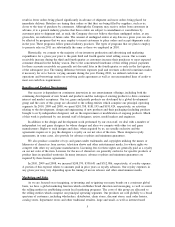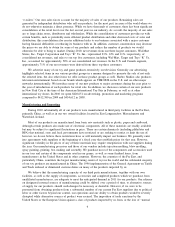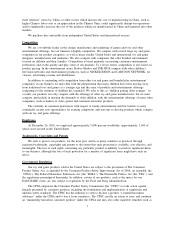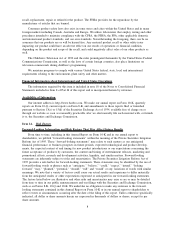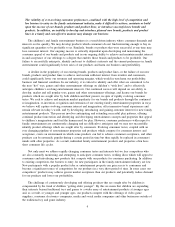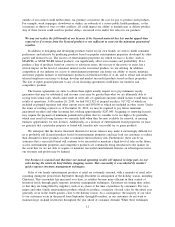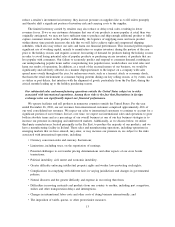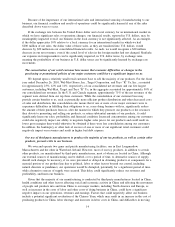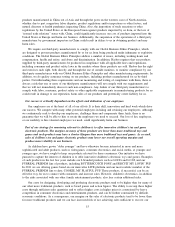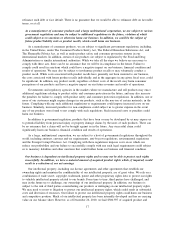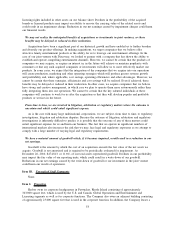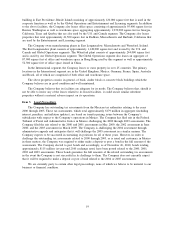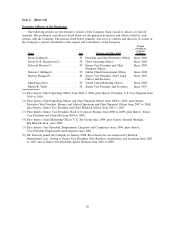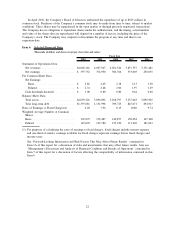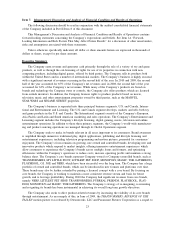Hasbro 2010 Annual Report Download - page 24
Download and view the complete annual report
Please find page 24 of the 2010 Hasbro annual report below. You can navigate through the pages in the report by either clicking on the pages listed below, or by using the keyword search tool below to find specific information within the annual report.Because of the importance of our international sales and international sourcing of manufacturing to our
business, our financial condition and results of operations could be significantly harmed if any of the risks
described above were to occur.
If the exchange rate between the United States dollar and a local currency for an international market in
which we have significant sales or operations changes, our financial results, reported in U.S. dollars, may be
meaningfully impacted even if our business in the local currency is not significantly affected. As an example,
if the dollar appreciates 10% relative to a local currency for an international market in which we had
$200 million of net sales, the dollar value of those sales, as they are translated into U.S. dollars, would
decrease by $20 million in our consolidated financial results. As such, we would recognize a $20 million
decrease in our net revenues, even if the actual level of sales in the foreign market had not changed. Similarly,
our expenses in foreign markets can be significantly impacted, in U.S. dollar terms, by exchange rates,
meaning the profitability of our business in U.S. dollar terms can be significantly harmed by exchange rate
movements.
The concentration of our retail customer base means that economic difficulties or changes in the
purchasing or promotional policies of our major customers could have a significant impact on us.
We depend upon a relatively small retail customer base to sell the majority of our products. For the fiscal
year ended December 26, 2010, Wal-Mart Stores, Inc., Target Corporation, and Toys “R” Us, Inc., accounted
for approximately 23%, 12% and 11%, respectively, of our consolidated net revenues and our five largest
customers, including Wal-Mart, Target and Toys “R” Us, in the aggregate accounted for approximately 50% of
our consolidated net revenues. In the U.S. and Canada segment, approximately 71% of the net revenues of the
segment were derived from our top three customers. While the consolidation of our customer base may
provide certain benefits to us, such as potentially more efficient product distribution and other decreased costs
of sales and distribution, this consolidation also means that if one or more of our major customers were to
experience difficulties in fulfilling their obligations to us, cease doing business with us, significantly reduce
the amount of their purchases from us, alter the manner in which they promote our products or the resources
they devote to promoting and selling our products, or return substantial amounts of our products, it could
significantly harm our sales, profitability and financial condition. Increased concentration among our customers
could also negatively impact our ability to negotiate higher sales prices for our products and could result in
lower gross margins than would otherwise be obtained if there were less consolidation among our customers.
In addition, the bankruptcy or other lack of success of one or more of our significant retail customers could
negatively impact our revenues and result in higher bad debt expense.
Our use of third-party manufacturers to produce the majority of our toy products, as well as certain other
products, presents risks to our business.
We own and operate two game and puzzle manufacturing facilities, one in East Longmeadow,
Massachusetts and the other in Waterford, Ireland. However, most of our toy products, in addition to certain
other products, are manufactured by third-party manufacturers, most of whom are located in China. Although
our external sources of manufacturing can be shifted, over a period of time, to alternative sources of supply,
should such changes be necessary, if we were prevented or delayed in obtaining products or components for a
material portion of our product line due to political, labor or other factors beyond our control, including
natural disasters or pandemics, our operations would be disrupted, potentially for a significant period of time,
while alternative sources of supply were secured. This delay could significantly reduce our revenues and
profitability, and harm our business.
Given that the majority of our manufacturing is conducted by third-party manufacturers located in China,
health conditions and other factors affecting social and economic activity in China and affecting the movement
of people and products into and from China to our major markets, including North America and Europe, as
well as increases in the costs of labor and other costs of doing business in China, could have a significant
negative impact on our operations, revenues and earnings. Factors that could negatively affect our business
include a potential significant revaluation of the Chinese Yuan, which may result in an increase in the cost of
producing products in China, labor shortage and increases in labor costs in China, and difficulties in moving
14



